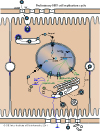HBx function as signaling molecule
General comment
HBx has been described as modulating many signaling pathways. It is unlikely that the 154aa protein is able to bind specific partners and play a role directly in all these pathways. Presumably it acts on few key modulators
of these pathways.
A) Cytoplasmic signaling pathways:
HBx has the capacity to modulate many cytoplasmic signaling pathways since it has been shown to up-regulate Src/Ras, SAPK/JNK, AKT/PKB, NF-kB, Janus kinase/STAT, PKC, PI3-K, FAK, PyK-2, p53 signaling transduction pathways (Wei et al. 2010) Rating=Review.
NF-kB-linked signaling pathways:
- HBx activates the Src-Ras-Raf-MEK-ERK pathway (Klein et al. 1999) Rating=2. Activation of Src signaling pathway enhances androgen receptor (AR)-mediated activity in the host, which might be the explanation for male predominance of HCC (male to female ratio about 6:1) (Chiu et al. 2007) Rating=1.
- Src pathway could be turned on by the focal adhesion kinase (FAK) or proline-rich kinase 2 ((Pyk)2) following HBx-induced release of calcium into the cytoplasm from intracellular calcium stores. FAK would then activate Src kinases and downstream signal transduction (NF-kB, AP-1-dependent transcription) and HBV DNA replication (Bouchard et al. 2006) Rating=1, (Bouchard et al. 2001) Rating=1.
- HBx activates a PI3-K dependent signaling pathway (Lee et al. 2001) Rating=1.
- HBx has been shown to induce activation of IkB kinase (IKK)/NF-kB signaling pathway. Increased levels of NF-kB have been related to HBx-mediated ubiquitination and nuclear translocation of IKK-alpha via AKT-dependent phosphorylation (Huang et al. 2011) Rating=2 and to HBx-induced up-regulation of TBK1 (Kim et al. 2010) Rating=1.
- There is a positive feedback loop between TNF-alpha/NF-kB and HBx (Shukla et al. 2011) Rating=1.
Comments:
HBV seems to trigger inter-related pathways. Possible aims could be to promote cell survival and/or optimal viral DNA replication. According to all concerned up-regulated proteins, FAK family kinases, including FAK and (Pyk)2, could be one of the target of HBx since they could on one hand activate PI3-K via Src kinases, leading to activation of AKT and subsequently of IKKb and NF-kB.
Antiapoptotic signaling pathways:
- HBx prevents apoptosis in normal cells through inhibition of pro-apoptotic p53 protein via direct interaction in the cytoplasm, sequestering and preventing p53 entry into the nucleus (Shukla et al. 2011) Rating=2. In addition, co-action with anti-apoptotic delta-TAp73 favors cell survival (PubMed 22030623) Rating=2.
- MEKK1, SEK1, SAPK, 14-3-3 protein, and HBx have been shown to form a complex in the cytoplasm thereby activating SAPK/JNK activity and suppression of Fas-mediated apoptosis (Diao et al. 2001) Rating=2.
Comments:
HBx has been reported to modulate apoptosis. Pro- or anti-apoptotic effects are probably cell context dependent, with HBx inducting apoptosis in transformed cells and inhibiting it in normal hepatocytes.
Might also achieves protection against apoptotic death through an HBx-P3K-AKT-Bad pathway and by inactivating caspase 3 activity, or in association with H-ras oncogene through activation of the phosphatidyl inositol-3 kinase and AKT pathway.
Cell cycle deregulation
- HBx activates the Wnt/beta-catenin signaling pathway by competitively binding APC to displace beta-catenin from its degradation complex. This leads to beta-catenin upregulation in the nucleus (Hsieh et al. 2011) Rating=1. Elevated beta-catenin level results in hyperactivated transcription of cyclin D, VEGF, and c-MYC, which could promote malignancy. Increased expression of beta-catenin in the cytoplasm or nucleus occurs in 50-70% of HCC patients, and its elevated level might thus play a role in HCC development (Suzuki et al. 2002) Rating=1.
- HBx, through its interaction with HBXIP, could deregulate centrosome duplication (Garcia-Saez et al. 2011, Wen et al. 2008) Rating=1.
- HBx might induce quiescent hepatocytes to enter the G1 phase of the cell cycle (Gearhart et al. 2010) Rating=1. This might be linked to HBx elevation of cytosolic calcium via release of calcium from intracellular calcium stores (Yang et al. 2011) Rating=1
- HBx might also be involved in deregulating the mitotic checkpoint and thus induce aberrant chromosomal segregation (Kim et al. 2008) Rating=1
B) Nuclear genes transactivation:
HBx performs transactivation by up-regulating the activity of a number of transcription factors such as nuclear factor kappa B (NF-kB), AP-1, AP-2, c-EBP, CREB/ ATF, SP1, HIF-a, E2F, NF-AT , (Diao et al. 2001). Interaction of HBx with the acetyltransferases CBP/p300 plays a central role in the activation of CREB-dependent transcription. Upregulating the activity of AP-1 might explain how HBx activates the transcription of DNMT1 (cf. HBx-induced DNA methylation).


